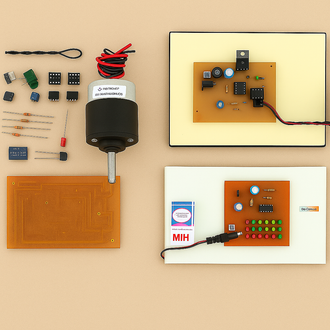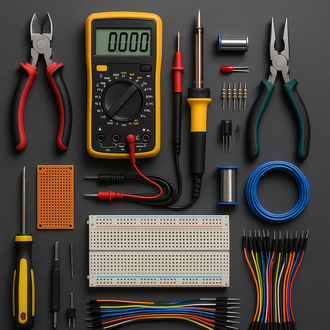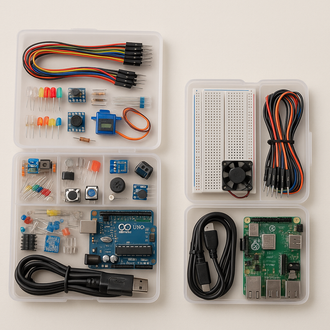
What Is the Principle of Solenoid? Definition, Working, Diagram & Magnetic Field
- 06 Oct, 2025
A solenoid is one of the easiest ways to change electricity into magnetism and motion. When you wrap insulated wire into a tight helix and send current through it, you make a strong, directed magnetic field that can power relays, valves, speakers, locks, and many other automation tasks. This guide explains the core concept of Ampere's law, discusses the Solenoid definition and solenoid meaning, explores the magnetic field within a solenoid, and provides a clear soenoid diagram showing lines of flux and polarity.
Definition and Meaning of Solenoid
A solenoid definition describes it as a long coil of wire tightly wound together. When an electric current flows through it, it produces a nearly uniform magnetic field inside the coil. Simply put, it’s an “electromagnet in a tube.” The solenoid meaning in engineering usually refers to coil-plunger actuators that convert electrical energy into linear motion.
The Principle Behind a Solenoid
Ampere's circuital law explains that an electric current generates a magnetic field moving around a closed path with strength proportional to μ times the enclosed current. For a tightly wound coil with N turns over a length ℓ, carrying current I, the magnetic field within a solenoid is given by B ≈ μ n I, where n = N/ℓ (turns per meter) and μ is the permeability (μ = μ0μr).
This stacking of many loops strengthens the internal field and keeps it uniform, while the external field largely cancels out.
Inside a Solenoid: The Magnetic Field
For a long coil, the magnetic field within a solenoid remains nearly uniform and parallel to the axis. You can enhance B using the relation B ≈ μ n I by:
- Increasing current I (within safety limits)
- Adding more turns per unit length (n)
- Using a high-μ core (soft iron, ferrite) to increase μr
The right-hand grip rule shows direction: the thumb points along the axial field, and the fingers curl in the current direction.
Diagram of a Soenoid (Field Lines and Polarity)
A labeled soenoid diagram visually demonstrates the current’s path, the internal field, and leakage lines connecting both ends. Arrows indicate B along the axis, and end faces display N/S poles clearly.
Quick Math: Example Calculation
Suppose a solenoid has N = 1200 turns, ℓ = 0.30 m, I = 0.8 A, and an iron core with μr ≈ 800. Then, n = N/ℓ = 4000 m⁻¹. With μ0 = 4π×10⁻⁷ H/m, μ = μ0μr, giving:
B ≈ μ n I = (4π×10⁻⁷ × 800) × (4000) × (0.8) ≈ 0.32 T.
Compared to air, a high-permeability core increases the field hundreds of times—an essential detail of the magnetic field within a solenoid.
Solenoids in Theory vs. Reality
- Ideal: Internal field perfectly uniform, external field zero.
- Real: Finite length causes fringing; center remains most uniform.
- Resistance and heating depend on wire gauge and duty cycle.
- AC use leads to core losses from hysteresis and eddy currents.
Core Materials and How They Work
Air cores offer linear response, low B, and quick reaction—ideal for RF coils and speakers.
Soft iron or steel provides a high μr, producing strong B—perfect for actuators and valves.
Ferrites minimize eddy losses in AC applications, improving efficiency.
Adding a ferromagnetic plunger strengthens focus and enhances linear motion.
Summary of Work
- Voltage causes current flow through helical turns.
- Each loop forms a circular magnetic field.
- Axial fields combine for a nearly uniform internal B.
- Adding a ferromagnetic core amplifies pull force.
Design Considerations
- Optimize N/ℓ ratio for desired B uniformity.
- Balance resistance, I²R heating, and coil size.
- Use PWM or intermittent duty to limit thermal rise.
- Include flyback diodes for DC drive protection.
Questions and Answers
Is the field zero outside a solenoid? No, it’s small but nonzero for finite coils.
How to switch poles? Reverse current direction; N/S ends flip.
Why add a core? High-μ materials enhance B, shrinking actuator size.
Uses for Solenoids
Solenoids power electromechanical devices like relays, valves, door locks, automotive actuators, printers, and magnetic holders. Their ability to convert electrical energy to motion underlies most automation systems.
Check out KitsGuru Solenoids & Electromagnets for educational kits and industrial-grade components.
Important Things to Remember
- Ampere’s law: B ≈ μ n I inside a long coil.
- Field strength varies with turns, current, and permeability.
- Consider end effects, heat, and core losses.
- Always verify orientation using a labeled soenoid diagram.
Learn more about Solenoid definition, solenoid meaning, and magnetic field within a solenoid in practical engineering contexts.
#solenoid principle #solenoid definition #magnetic field #solenoid diagram #uses
















